When it comes to landscape painting, very few English artists can hold a candle to the impressive oeuvre of this artist of the Romantic era.
John Constable (1776-1837) was born in Suffolk and although he traveled quite a bit during his lifetime, many of his most famous paintings depict an area called Dedham Vale.
The area where he once lived is now referred to as “Constable Country” in honor of one of the most famous landscape painters in British history.
His art is characterized by a great sense of detail and vivid skies. They don’t feature the haziness that defines the paintings of J.M.W. Turner, his contemporary.
Although he never managed to become very successful in his native England during his lifetime, his Romantic paintings were admired in France. They inspired the landscape painters of the Barbizon School in the 1830s.
In this list, you can discover some of the most famous paintings by John Constable.
1. Wivenhoe Park
- Date created: 1816
- Dimensions: 56.1 × 101.2 centimeters (22.1 × 39.8 inches)
- Location: National Gallery of Art, Washington, D.C., United States
Wivenhoe Park is the title of a painting that depicts a large green area that is situated at the eastern edge of Colchester. This immense parkland covers an area of about 81 hectares (200 acres) and provided enough elements for John Constable to produce an amazing painting.
The work was commissioned by Major General Francis Slater-Rebow, the man who owned this piece of land at the time. he was one of the first patrons of the artist and greatly helped him to become financially free. The simplicity of this work is what defines the nostalgia felt by Constable for the simple life.

2. The Vale of Dedham
- Date created: 1828
- Dimensions: 144.5 × 122 centimeters (56.9 × 48 inches)
- Location: Scottish National Gallery, Edinburgh, Scotland
The Vale of Dedham is one of the many paintings by John Constable that depicts the area known as Dedham Vale. This area is on the Essex-Suffolk border in the eastern part of England and is where the artist lived for most of his life.

The artist thoroughly enjoyed painting his home region and he also believed that these were his best works. He referred to the matter as “I should paint my places best.” This work depicts the view from Gun Hill toward Dedham Village. The River Stour can be seen flowing through the countryside.

3. The Hay Wain
- Date created: 1821
- Dimensions: 130.2 × 185.4 centimeters (51.25 × 73 inches)
- Location: National Gallery, London, United Kingdom
The Hay Wain provides an even closer view of the River Stour in Constable Country. This intimate depiction of rural life during the artist’s time, in the wake of the Industrial Revolution and looming urbanization, has made this one of Constable’s most famous paintings.
The work depicts three horses pulling what appears to be a wagon across the River Stour. The cottage in the left part of the painting has been identified as Willy Lott’s Cottage. This house still stands here today although it has been restored in the 1920s. It was designated a Grade I listed building in 1955.
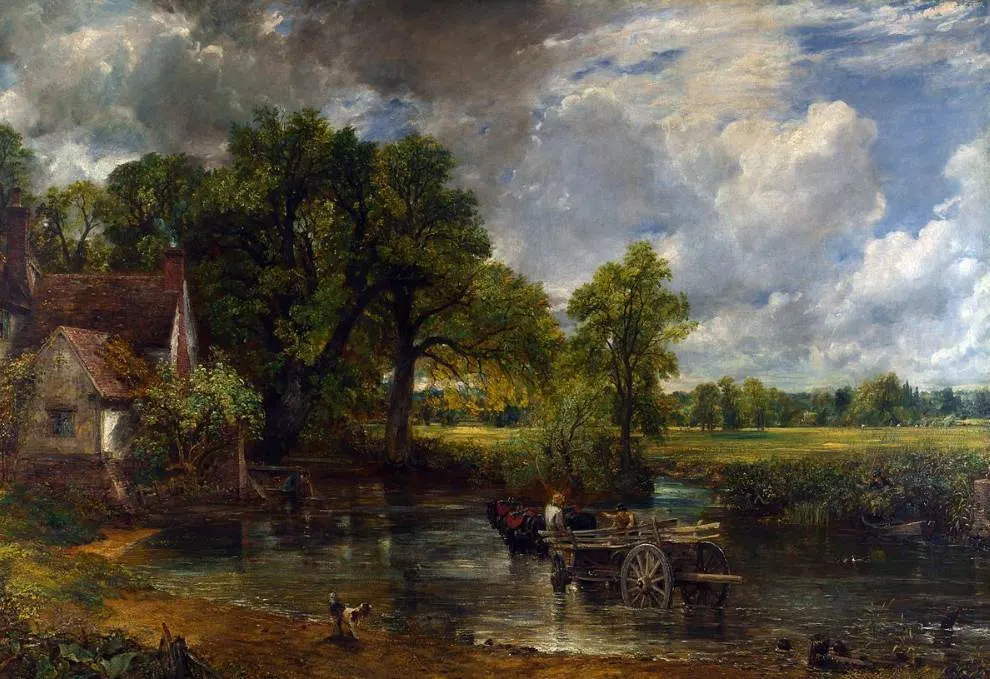
4. Salisbury Cathedral from the Meadows
- Date created: 1831
- Dimensions: 153.7 × 97 centimeters (60.5 × 38 inches)
- Location: Tate Britain, London, United Kingdom
Salisbury Cathedral from the Meadows is a magnificent work of art that depicts Salisbury Cathedral in Wiltshire, South West England. He completed the work in 1831, three years after his wife Maria passed away. He did, however, continued to change some details in the following years.
One of the changes was the addition of 9 lines from the poem “The Seasons” by 18th-century poet James Thompson. This revealed the true meaning of the painting as the rainbow is a sign of hope following the death of his wife at the young age of 41.
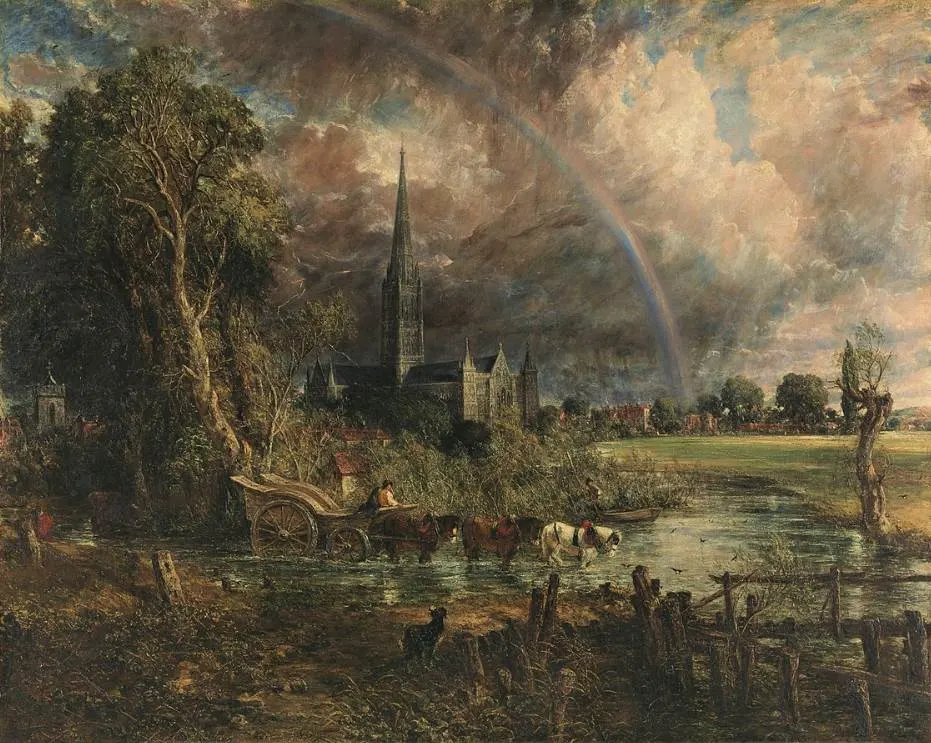
5. The White Horse
- Date created: 1819
- Dimensions: 131.4 × 188.3 centimeters (51.7 × 74.1 inches)
- Location: Frick Collection, New York City, United States
The White Horse appears to be a typical John Constable landscape painting initially, but it has a special place in the artist’s oeuvre. It was the first of the so-called “six-footers,” a series of paintings that were much larger than the ones he produced earlier.
These paintings depict scenes in Dedham Vale near the River Stour. It’s another work that depicts a horse crossing the river in a small village called Flatford, Suffolk. The painting was exhibited at the Royal Academy in London in 1819 and was very well received by art critics.

6. The Lock
- Date created: 1824
- Dimensions: 121 × 140 centimeters (47.5 × 56 inches)
- Location: Private Collection
The Lock is yet another painting depicting a rural scene on the River Stour. This one shows a man trying to open a lock called Dedham Lock. This allowed small boats to continue their journey on the River Stour, a river that empties into the North Sea at Harwich.
It’s another painting in which we can see a distant view of Dedham village as Dedham church sticks out in the background. This painting is part of a private collection after it was purchased for the sum of £22,441,250 at Christie’s in London in July 2012. This just emphasizes the value of Constable’s paintings on the art market in recent times.
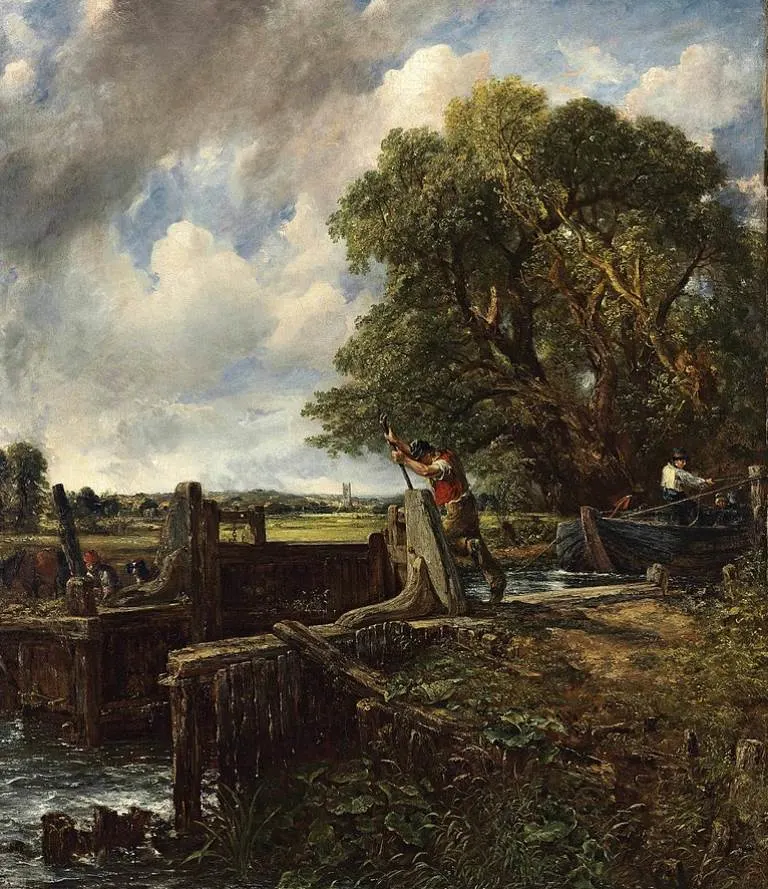
7. The Cornfield
- Date created: 1826
- Dimensions: 143 × 122 centimeters (56 × 48 inches)
- Location: National Gallery, London, United Kingdom
The Cornfield is a painting that depicts the road leading from the small town of East Bergholt to the village of Dedham. The most remarkable element in this painting is the young shepherd boy who appears to be drinking from a small pond, indicating the fact that it was a hot Summer day.
The presence of this boy resulted in Constabel referring to this work as “The Drinking Boy.” Another remarkable fact about his painting is that Constable got advice from a botanist named Henry Phillips. This means that the plants and trees in this work are depicted as accurately as possible.
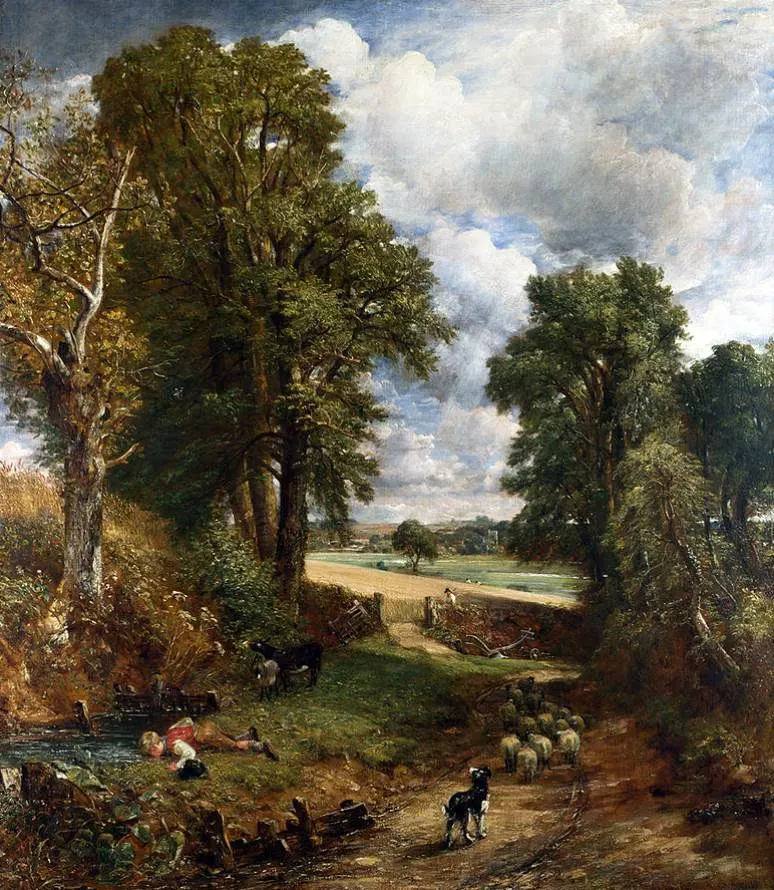
8. Hadleigh Castle, The Mouth of the Thames, Morning after a Stormy Night
- Date created: 1829
- Dimensions: 121.9 x 164.5 centimeters (47.99 x 64.76 inches)
- Location: Yale Center for British Art, New Haven, United States
Hadleigh Castle is the common title of a work that is fully known as “Hadleigh Castle, The Mouth of the Thames, Morning after a Stormy Night.” It depicts Hadleigh Castle, a ruined fortification in the utmost southeastern part of Essex and just south of the town of Hadleigh.
The River Thames Estuary, the area where the river empties into the North Sea, is located just south of this castle. John Constable visited this castle in 1814 and produced several drawings of it. He completed this work about 15 years later and it was displayed at the exhibition of the Royal Academy that year.
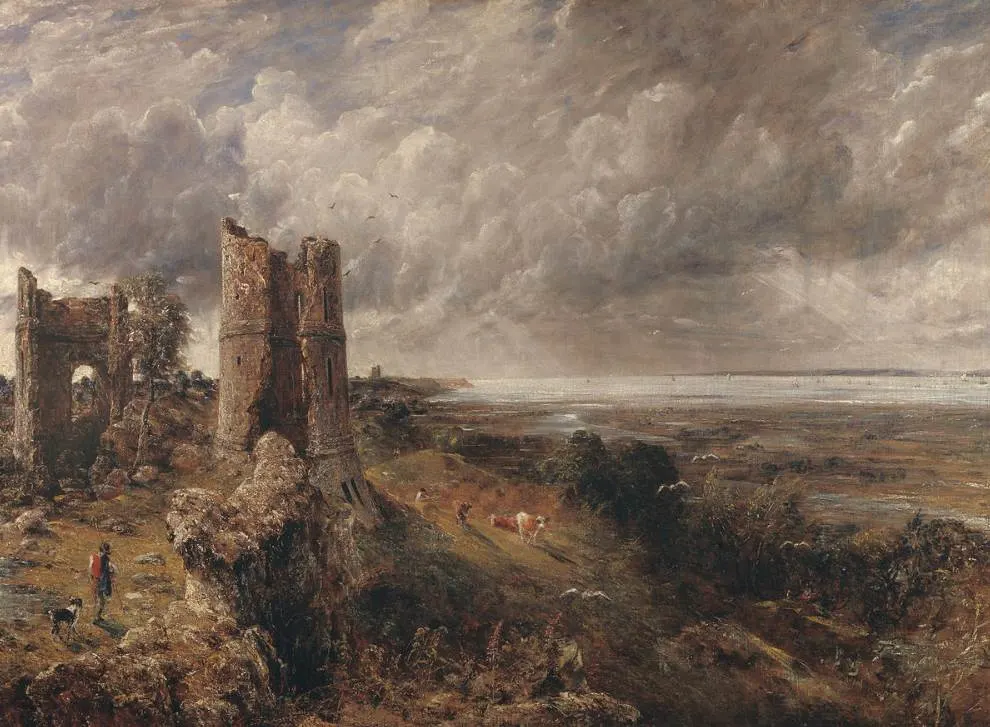
9. Stratford Mill
- Date created: 1820
- Dimensions: 127 x 182.9 centimeters (50 x 72 inches)
- Location: National Gallery, London, United Kingdom
Stratford Mill was the second of the six-footers that John Constable produced at the height of his career. It depicts a water-powered paper mill that was located on an island just outside of the village of Stratford St. Mary. The children in the foreground can be seen fishing in the River Stour.
It’s another painting that was based on an earlier sketch of the same scene. This drawing was made in 1811 and is titled “Anglers at Stratford Mill.” It mainly focused on the children who are fishing in the river and the painting extended the view to include the mill and the landscape on the right.
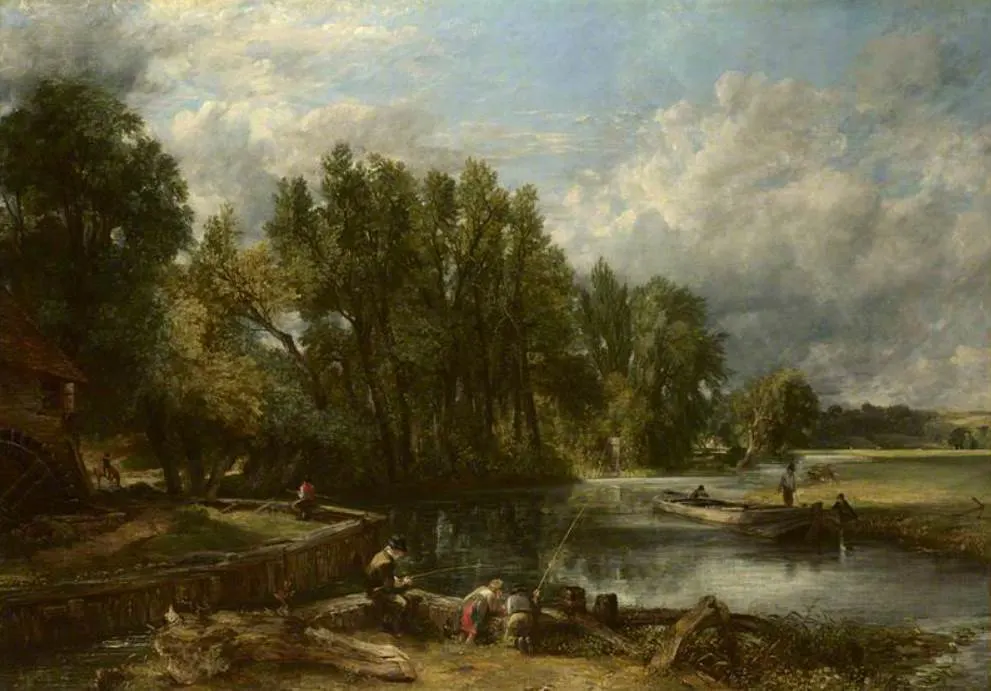
10. Salisbury Cathedral from the Bishop’s Grounds
- Date created: 1823
- Dimensions: 87.6 × 111.8 centimeters (34.5 × 44 inches)
- Location: Victoria & Albert Museum, London, United Kingdom
Salisbury Cathedral from the Bishop’s Grounds is another amazing painting by John Constable that depicts one of the most famous Gothic cathedrals in England. This painting was commissioned by John Fisher, the Bishop of Salisbury and a close friend of the artist. Constable painted the first version of the work in 1823 and this painting has been in the collection of the Victoria & Albert Museum in London since 1857.
He completed a second version that features the same composition but is slightly more colorful in 1825. This work is part of the Frick Collection in New York City. An earlier oil sketch completed in 1822 is part of the collection of the São Paulo Museum of Art in São Paulo, Brazil.

